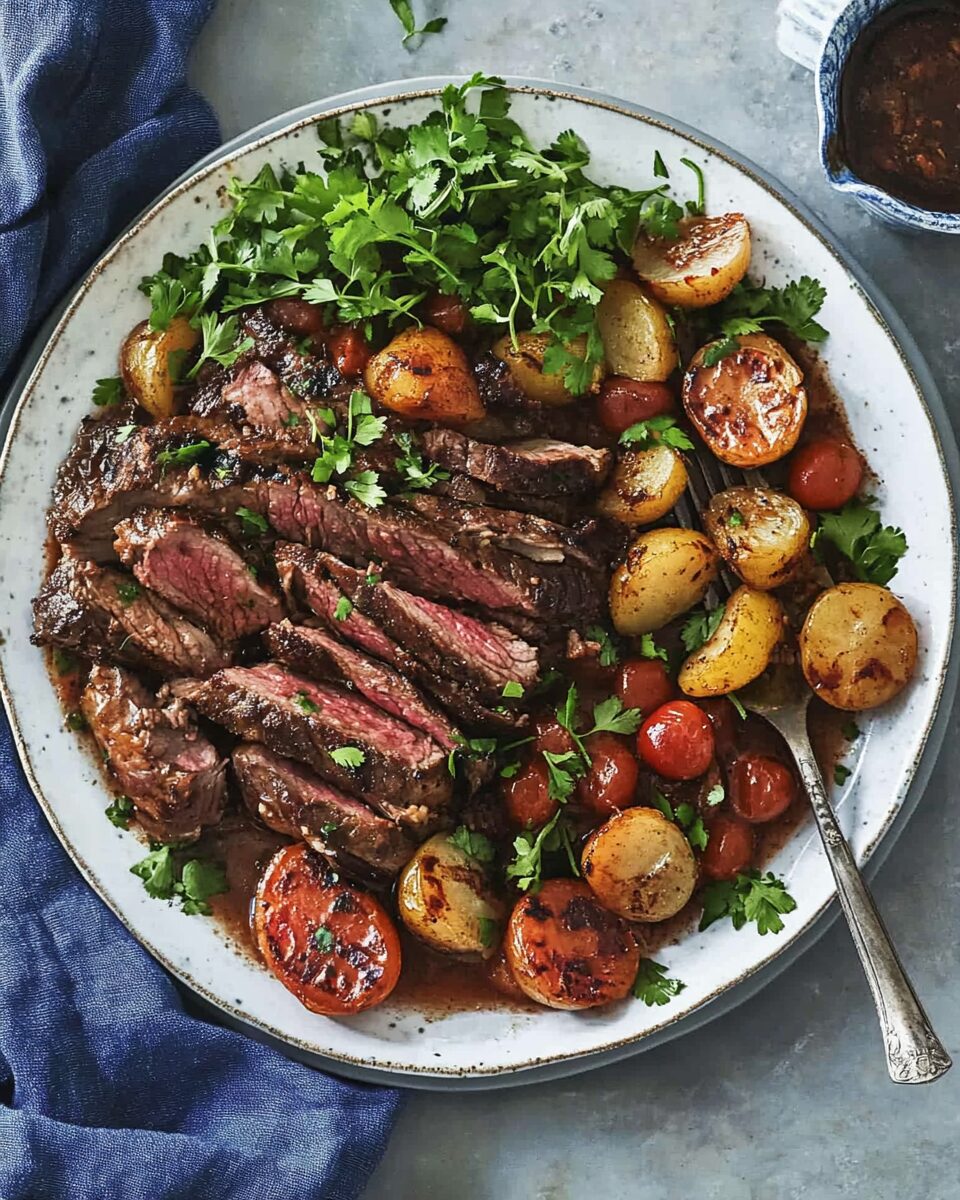Portuguese Carne Assada is a traditional Azorean dish featuring tender braised beef, small red potatoes, chouriço, and onions. This hearty meal is a staple in Portuguese cuisine, offering rich flavors perfect for a comforting dinner.
Full Recipe:
Ingredients
-
8 garlic cloves, crushed and peeled
-
1 (26-ounce) bottle dry red wine
-
3 tablespoons double-concentrate tomato paste (or 4 1/2 tablespoons regular tomato paste)
-
1 teaspoon chopped oregano leaves
-
2 bay leaves
-
1 tablespoon sweet paprika
-
1 tablespoon smoked sweet paprika
-
1 1/2 teaspoons crushed red pepper flakes (adjust to taste)
-
Kosher salt, to taste
-
1 (4-pound) boneless chuck roast, tied
-
Freshly ground black pepper
-
3 tablespoons olive oil (plus more as needed)
-
2 large yellow onions, coarsely chopped
-
1 cup water
-
1 1/2 pounds Portuguese chouriço, linguiça, or dry-cured smoked Spanish chorizo, cut into several pieces
-
1 1/2 pounds small red potatoes (about golf-ball size), peeled (optional)
-
1/2 pound baby carrots
-
Chopped flat-leaf parsley leaves, for garnish
Directions
-
In a large nonreactive bowl, combine the garlic, wine, tomato paste, oregano, bay leaves, both paprikas, red pepper flakes, and 1 teaspoon of salt. Add the beef, ensuring it’s fully submerged. Cover and refrigerate for at least 2 hours or overnight, turning the beef occasionally.
-
Preheat the oven to 325°F (163°C), positioning a rack in the lower third.
-
Remove the beef from the marinade, reserving the liquid. Pat the meat dry and season with salt and pepper.
-
In a large Dutch oven over medium-high heat, warm the olive oil. Sear the beef on all sides until browned, about 5 minutes per side. Transfer to a plate.
-
Reduce the heat to medium. If needed, add more oil. Sauté the onions until golden brown, about 15 minutes. Add the garlic and cook for an additional 3 minutes.
-
Pour the reserved marinade and water into the pot, bringing it to a boil. Return the beef to the pot, cover tightly, and place in the oven. Braise, turning and basting the meat every 20 minutes, until tender, approximately 2 1/2 to 3 hours.
-
Add the chouriço, potatoes, and carrots to the pot. Continue braising, covered, for another 30 minutes.
-
Remove the beef and let it rest, covered, to keep warm. Increase the oven temperature to 400°F (200°C) and return the pot, uncovered, to the oven. Roast the vegetables and sausage until the potatoes are tender, 15 to 30 minutes.
-
Slice the beef and chouriço. Serve on a platter surrounded by the vegetables, drizzled with the cooking sauce and garnished with parsley.
Nutrients
Per serving (based on 10 servings):
-
Calories: Approximately 702 kcal
-
Protein: 50g
-
Carbohydrates: 20g
-
Dietary Fiber: 3g
-
Sugars: 4g
-
Fat: 45g
-
Saturated Fat: 15g
-
Cholesterol: 140mg
-
Sodium: 800mg
-
Potassium: 1200mg
-
Vitamin A: 5000 IU
-
Vitamin C: 20mg
-
Calcium: 60mg
-
Iron: 6mg
Cultural Significance
Portuguese cuisine is more than just a collection of ingredients and techniques—it’s a reflection of the country’s identity, heritage, and values. Carne Assada exemplifies the Portuguese approach to food: simple, hearty, and made to be shared. Family meals in Portugal are long, joyous affairs where multiple generations gather at the table. Carne Assada frequently appears at Sunday lunches, festive gatherings, and special occasions, offering nourishment and celebration all in one dish.
In the Azores, a group of volcanic islands in the mid-Atlantic, Carne Assada plays a special role. Many Azorean dishes were developed as responses to the isolated, resource-limited conditions of island life. This meant making the most of available ingredients, often by enhancing them with robust seasoning and preservation methods. The use of wine, vinegar, and spice blends in Carne Assada not only tenderizes the meat but also enhances shelf life and flavor—an old-world solution with lasting appeal. Food in Portugal is inherently social, and Carne Assada’s family-style presentation and hearty components make it ideal for communal dining. This is not a dish made for one, but for many, served at the center of the table in a large pot or on a platter, surrounded by potatoes, carrots, and sausage. It is eaten slowly, savored between conversation and laughter, and followed by lingering over espresso or port wine.
Historical Background
The Portuguese culinary tradition is the result of centuries of exploration, trade, and cultural exchange. During the Age of Discoveries in the 15th and 16th centuries, Portuguese explorers traveled across the globe, establishing trade routes and colonies that brought back not only spices and ingredients but also new cooking techniques. As a result, Portuguese food today is a flavorful mosaic, combining European staples with African, South American, and Asian influences.
Carne Assada is a product of this heritage, combining New World ingredients like potatoes and peppers with Old World staples such as beef, wine, and garlic. The use of paprika and chouriço, both influenced by Iberian traditions, adds richness and complexity. The incorporation of slow cooking, marination, and layering of spices reflects a global sensibility refined over centuries of travel and adaptation.
In rural Portuguese communities, dishes like Carne Assada were born out of practicality and necessity. Tough cuts of meat were made tender through braising, a technique passed down through generations. Home cooks developed a sense for seasoning, adjusting spices to taste, ensuring balance and depth. Over time, Carne Assada became not only a way to stretch ingredients but also a source of pride—an emblem of homegrown flavor and craftsmanship.
Key Elements of Flavor
Carne Assada is a dish of patience and reward. The depth of flavor achieved in a properly made Carne Assada comes from multiple layers of technique and timing. The process typically begins with a marinade, often made of red wine, garlic, paprika, and bay leaves. This initial step tenderizes the beef and infuses it with flavor before it even hits the heat.
Searing the beef is the next key step. This caramelizes the surface, creating a rich crust that adds to the final flavor and texture. After that, the meat is braised slowly in its marinade, along with onions, sausage, and sometimes additional water or stock. This long, moist cooking process allows the meat’s connective tissue to break down and become tender, resulting in a luscious texture that yields effortlessly to a fork.
A Dish of Celebration and Memory
Many Portuguese families associate Carne Assada with specific memories—grandmothers stirring pots on Sunday mornings, the scent of wine and garlic filling the home, a dish that signals togetherness and warmth. While Carne Assada can be made any day of the week, its slow-cooked nature makes it especially suitable for weekends or special occasions when there’s time to let the pot simmer and the flavors deepen.
In emigrant communities, especially in the United States, Canada, and Brazil, where large Portuguese populations reside, Carne Assada has become a cherished culinary anchor. It serves as a tangible connection to homeland, heritage, and ancestry. In this way, the dish transcends its ingredients to become a symbol of identity, passed from one kitchen to another.
Modern Interpretations and Global Reach
As with many traditional dishes, Carne Assada has found new life in modern kitchens. While the essential components remain, cooks today are experimenting with everything from Instant Pots to sous-vide machines to streamline the process. Some lighten the dish with leaner meats or add contemporary twists like balsamic reductions or fresh herbs not typically used in traditional Portuguese cuisine. Vegetarians and health-conscious eaters have also found ways to adapt Carne Assada, substituting the beef with plant-based proteins or mushrooms while retaining the flavor-rich marinade and vegetable medley.
How Carne Assada Represents Portuguese Values
Portuguese cuisine often emphasizes humility, tradition, and resilience—values that are mirrored in Carne Assada. This is not a dish designed to impress with extravagant flair but to satisfy deeply, to comfort, and to bring people together. It shows reverence for ingredients, appreciation for time-honored methods, and pride in cultural heritage.
The act of making Carne Assada from scratch reflects the Portuguese respect for craft. There is no rushing a pot roast that takes hours to become perfect. It invites the cook to slow down, to be present, to nurture something with care. It is a form of domestic artistry passed down generationally, from parents to children, and now into global food culture through digital sharing and culinary curiosity.
Serving and Enjoying Carne Assada
When it comes time to serve, Carne Assada offers versatility. While it shines on its own, it can be accompanied by rice, simple salads, or crusty bread. In Portugal, meals often include a soup starter and finish with a modest dessert—perhaps flan or fruit—followed by espresso. Carne Assada fits beautifully within this rhythm.
Conclusion
Portuguese Carne Assada is much more than a beef dish—it is a culinary bridge between generations, geographies, and traditions. It tells the story of a seafaring nation that brought back spices and ideas from around the world, yet always returned to the warmth of the home kitchen.






